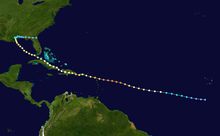Effects of Hurricane Georges in Haiti
| Category 1 hurricane (SSHWS/NWS) | |
 Hurricane Georges making landfall in the Dominican Republic as a Category 3 hurricane | |
| Winds | 1-minute sustained: 75 mph (120 km/h) |
|---|---|
| Pressure | 990 mbar (hPa); 29.23 inHg |
| Fatalities | At least 400 total |
| Damage | $200 million (1998 USD) |
| Areas affected | Haiti |
| Part of the 1998 Atlantic hurricane season | |
The effects of Hurricane Georges in Haiti included about $200 million (1998 USD, $315 million 2019 USD) in damages and at least 400 fatalities.
Background

Hurricane Georges began as a tropical wave that moved off the coast of Africa during mid-September 1998. Tracking westward, the wave spawned an area of low pressure two days later, which quickly strengthened into a tropical depression. On September 16, the depression was upgraded to Tropical Storm Georges, and to Hurricane Georges the next day. The storm reached its peak intensity on September 20 with winds of 155 mph (250 km/h), just below Category 5 status on the Saffir-Simpson Hurricane Scale.[1]
Over the following five days, the hurricane tracked through the Greater Antilles, causing over 600 fatalities, mainly in Haiti and the Dominican Republic. By September 25, Georges entered the Gulf of Mexico as a Category 2 hurricane. The storm made landfall three days later near Biloxi, Mississippi with winds of 105 mph (165 km/h). Upon landfall, the hurricane's forward motion slowed to an eastward drift. Georges continued to diminish until it completely died down on October 1 near the Atlantic coast of Florida.[1]
Impact
Georges was already a weakened hurricane upon reaching Haiti, but cities and other areas of low elevation were still in danger of high winds, mudslides, and flooding. Haiti's capital received minimal damage.[2] The rest of the country, however, experienced a significant number of flash floods due to deforestation along the mountains.[3] Mudslides destroyed or severely damaged many houses, leaving 167,332 homeless.[1] Floods left the greatest impact along the northern coastline.[3] On the southern coast, the head of a U.S.-based medical team, stranded for several days by flooding in the remote town of Belle Anse, anticipated a rise in malnutrition, disease, homelessness and poverty.[4] Hurricane Georges caused citizens to have no access to clean water, which added to the already unsanitary conditions from dirty flood water and rampant diseases.[5] In all, there were at least 400 fatalities.[6]
Like in the Dominican Republic, the agricultural sector suffered extreme damage. After a severe drought in 1997, Georges's severe flooding stopped any chances of recovering quickly. Most of the country's significant crop land, including Artibonite Valley, suffered total losses. Up to 80% of banana plantations were lost, while vegetable, roots, tubers, and other food crops were destroyed. In addition, thousands of livestock were missing.[7] Total agricultural losses amounted to $179 million (1998 USD, $281 million 2019 USD).[8]
Aftermath
The country requested food assistance in the aftermath of the hurricane to alleviate the serious losses.[7] Organizations such as the BHR/OFDA offered monetary assistance and provided limited amounts of resources such as blankets, water, and plastic sheeting.[9] CWS sent some of its members to Haiti to scope the extent of aid needed and provided kits containing cleaning supplies and toiletries.[10] CWS and FEMA partnered together to gather volunteers and oversee rebuilding efforts.[11] Cuba provided medical assistance and gave additional training to Haitian doctors through an agreement made with Haiti.[12]
See also
- Hurricane Georges
- Effects of Hurricane Georges in the Dominican Republic
- 1998 Atlantic hurricane season
References
- ^ a b c John L. Guiney (January 5, 1999). "Hurricane Georges Tropical Cyclone Report". National Hurricane Center. Retrieved August 4, 2009.
- ^ "ReliefWeb: Caribbean, Dominican Republic, Haiti -- Hurricane Georges Fact Sheet #2,". 2007-09-27. Archived from the original on 2007-09-27. Retrieved 2019-10-06.
- ^ a b "Haiti: Hurricane Death Toll Hits 147". 2007-10-11. Archived from the original on 2007-10-11. Retrieved 2019-10-06.
- ^ "Wayback Machine" (PDF). 2007-09-26. Archived from the original (PDF) on 2007-09-26. Retrieved 2019-10-06.
- ^ "ReliefWeb: Impact Situation Report - Hurricane Georges - Republic of Haiti". 2007-09-27. Archived from the original on 2007-09-27. Retrieved 2019-10-06.
- ^ "Haiti's Hurricane History | Weather Underground". www.wunderground.com. Retrieved 2019-10-06.
- ^ a b Economic and Social Development Department (October 13, 1998). "Hurricane "Georges" Causes Extensive Crop Damage in Caribbean Countries". Food and Agriculture Organization of the United Nations. Archived from the original on November 6, 2007. Retrieved April 20, 2009.
- ^ Office of U.S. Foreign Disaster Assistance (October 8, 1998). "Eastern Caribbean, Dominican Republic, Haiti - Hurricane Georges Fact Sheet #9, Fiscal Year (FY) 1999". United States Agency for International Development. Archived from the original on September 27, 2007. Retrieved April 21, 2009.
- ^ "Caribbean, Dominican Republic, Haiti - Hurricane Georges Fact Sheet #9 - Antigua and Barbuda". ReliefWeb. Retrieved 2019-10-06.
- ^ "Expanded emergency appeal : Hurricane Georges - Cuba". ReliefWeb. Retrieved 2019-10-18.
- ^ "NCC/CWS Channels Aid to Caribbean Following Hurricane Georges". www.ncccusa.org. Retrieved 2019-10-18.
- ^ Kirk, Emily, and John M. Kirk. "Cuban Medical Cooperation in Haiti: One of the World's Best-Kept Secrets." Cuban Studies 41 (2010): 166,172,209-210. ProQuest. Web. 18 Oct. 2019.
